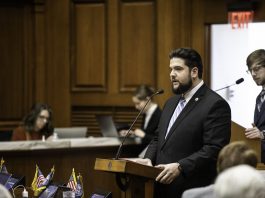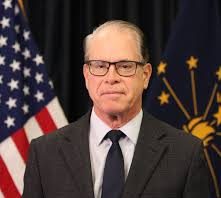Indiana Chamber of Commerce Blames Education Failures For State’s Brain Drain
The Indiana Chamber of Commerce released a report called “Indiana’s Leaking Talent Pipeline†this week. This report includes findings about Hoosiers going to college, taking advantage of government programs like the FAFSA, and utilizing unemployment, concluding that Indiana needs to “lift up the educational attainment and workforce skills of its citizenry.â€

“We hear it from employers, and we see it in virtually every education and workforce statistic. It’s that Indiana has a massively leaking talent pipeline,†declares Indiana Chamber President and CEO Kevin Brinegar.
The report found that fewer than half of all Hoosiers have an associate degree or high-quality credential (a certificate or certification), ranking the state 37th in the nation and lower than the U.S. average of 51.9%.
Of Indiana’s almost 80,000 high-school freshmen, only 89.6% graduated four years later. Of that number, 43.3% went on to enroll in college, and only 22.8% of that number completed college.
The report notes that, in 2022, ILEARN results show only 30.2% of students were proficient in math/English—an increase from 28.6% in 2021. However, the Chamber notes that the “results from 2021-22 show that nearly one in five students (18%) has not mastered foundational reading skills by the end of third grade.â€
“Students who are poor readers at the end of third grade are likely to remain poor readers throughout their life. They even are less likely to graduate on time or may never receive their high school diploma,†said Lynn Schemel, director of assessment for the Indiana Department of Education.
Reactions came from the Indiana Coalition for Public Education, a nonpartisan advocacy organization made up of parents, grandparents, educators, retired superintendents and community members, including three former state superintendents: Dr. Suellen Reed, Glenda Ritz and Dr. Jennifer McCormick.
“How does the Chamber claim the ILEARN as a reflection of failure when this is a new test (2019? just before Covid?) and the scores can’t be compared with the ISTEP when it’s a different test? Also, how valid are any test scores during the massive disruption and crisis of the worldwide pandemic?†said Cathy Fuentes-Rohwer, president of the Indiana Coalition for Public Education, in an email to TheStatehouseFile.com.
One section of the report is titled “Too Many School Districts.†This section goes on to state that the 289 school districts in Indiana are “far too many†and “serve to restrict student achievement.â€
However, Fuentes-Rohwer disagrees.
“I also find it ironic that the Chamber (and I lump them in with the state legislature because they have been very supportive of what they call ‘education reform’: the laws affecting the classroom, the expansion of ‘school choice’ and public tax dollars going into private hands through vouchers or privately run charter schools, online schools, Education Savings Accounts, and more) is concerned with the number of school districts in Indiana and its consequences for Hoosier students,†she said.
“The number of schools and ‘systems’ of schools has skyrocketed since 2011. Charter schools open and close with the supposed whim of the ‘market,’ leaving children scrambling for other schools, uprooting them and disrupting their learning. Where is the consequence for this? Where is the $154 million that has been stolen from Indiana taxpayers by the Indiana Virtual School and Indiana Pathways Virtual Academy?â€
Meanwhile, two of the government programs highlighted in the report that is offered for students who are interested in attending college are not being utilized. These two programs are FAFSA, the Free Application For Student Aid, and 21st-Century Scholars.
FAFSA is a free application that students seeking higher education can fill out to determine if they are eligible to receive financial aid. Indiana has one of the lowest completion rates in the country at not quite 44%, compared to the national average of 57%.
“Successful 2022 legislation will ensure that families receive information about the FAFSA and its importance in accessing resources to pay for postsecondary education,†the report states. “However, the Legislature once again failed to enact legislation to make completing the FAFSA a default expectation for high school seniors (even with multiple opt-outs).â€
Indiana offers a 21st Century Scholars program that provides free college tuition for low-income students who graduate from high school and have completed the preparatory activities. However, this report found that only 40% of income-eligible students enrolled in the program and that fewer than 50% of those students completed the requirements in order to earn the scholarship.
“That participation level is shockingly low because students don’t know about it or have the support to apply. What needs to happen is for every qualified student to be made aware and automatically enrolled,â€Â Brinegar asserts.
The report states that 29% of 18-year-old Hoosiers will finish college and stay in Indiana. Of the 60,370 postsecondary graduates in Indiana, nearly 40% will leave within one year of graduation and over half within five years. The report states that those lost graduates “could go a long way towards addressing Indiana’s talent shortages†and that the “incentives for graduate retention should be seriously considered.”
“It is troubling to me that the Chamber of Commerce and the Indiana legislature aren’t taking any responsibility for the “brain drain” and failure of our state to provide employers with a college-educated workforce,†Fuentes-Rohwer said.




